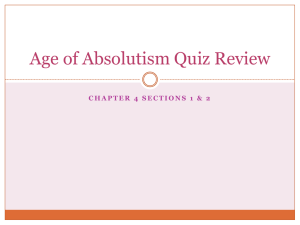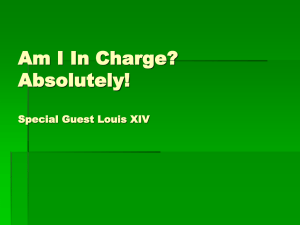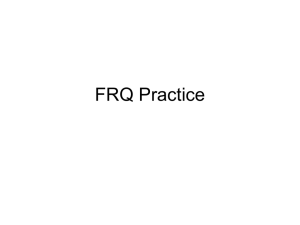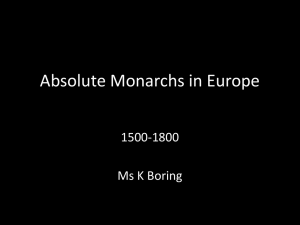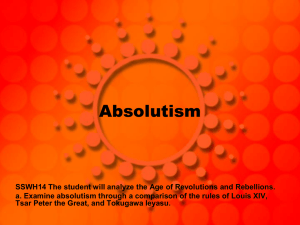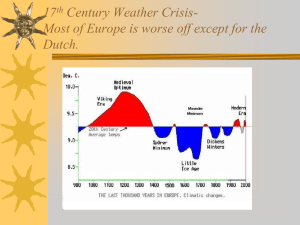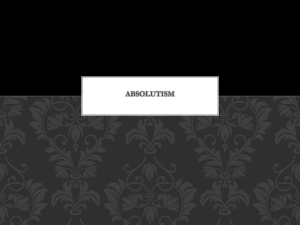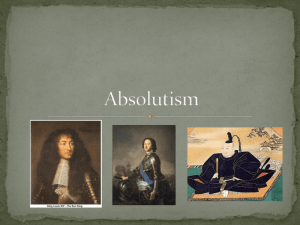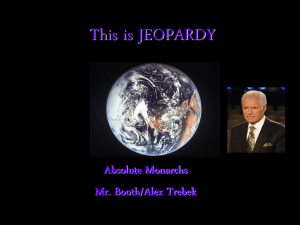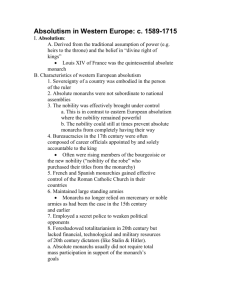Absolutism - AP European History
advertisement
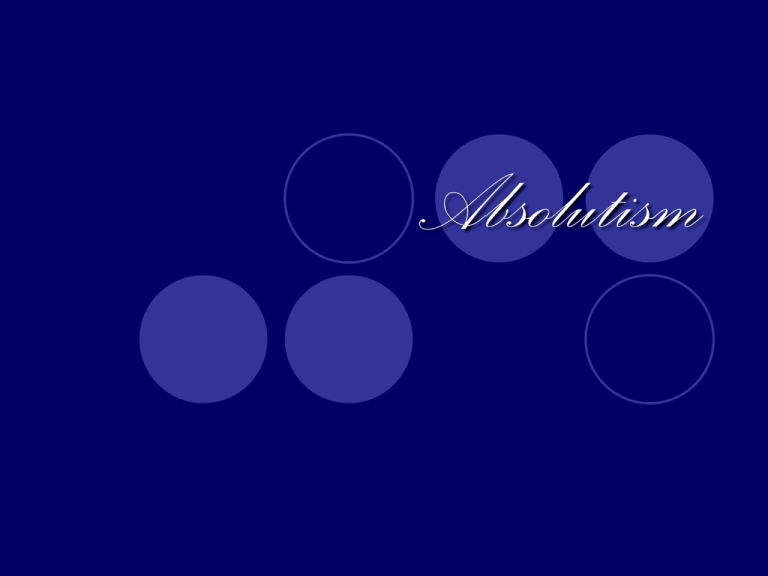
Absolutism Absolutism PhilosophyJean Bodin First to provide basis for absolutist states Believed absolutism could provide order and force people to obey the government Bishop Jacques Bossuet Divine right of kings King placed on throne by God and therefore owed his authority to no man or group Thomas Hobbes, Leviathan Pessimistic view of man’s natural state (“solitary, poor, nasty, brutish, and short”) Did not favor “divine right” Enlightened Despotism Characteristics of Absolutism Monarchs not subordinate to national assemblies, parliaments, etc. Nobility brought under the control of the monarch Bureaucracies composed of career officials who were responsible directly to the king Some gain control of the Church Maintained large standing armies Employed secret police to undermine enemies Comparison of Methods Comparing Medieval v. Absolutism View of relationship between God and the King The raising of finances Changes in the bureaucracy Changes in the military Absolutism v. Modern Totalitarianism Why does absolutism not qualify as a totalitarian form of government? In what ways to they share similar goals? The Development of French Absolutism th France in the 17 Century Feudal Estates First Estate: Clergy (1% of population) Second Estate: Nobility (3-4% of population) Third Estate: Bourgeoisie (Middle class) Order of rank restored under Henry IV Mostly agrarian 90% Largest country in Europe (17 million) Henry IV (Henry of Navarre) Strengthened social and government institutions: parliaments, treasury, universities, the Church Edict of Nantes- some recognition of Calvinism Weakened the nobility Nobility of the sword- not allowed to influence the royal council Nobility of the robe- new officials who had purchased titles Duke of Sully Finance minister Mercantilism- increased the role of the state in economy Granted monopolies on salt and gunpowder Encouraged new industry Only royal government could operate mines Reduced royal debt Reformed the tax system Oversaw transportation Louis XIII Henry IV assassinated, Marie de’ Medici rules as regent Regency is corrupt Cardinal Richelieu Politique Intendant System- replaced local officials with civil servants responsible directly to the king Increased taxation for military Subdue the Protestants: Peace of Alais Thirty Years’ War Richelieu and Louis XIII sought to weaken the Habsburg Empire France supports Gustavus Adolphus with money during the “Swedish Phase” “International Phase” Treaty of Westphalia France under Louis XIV Louis XIV “L’ etat, c’est moi”- “I am the state” Becomes known as the Sun King because he was the center of French power Believer in Divine Right Longest reign in European history (72 years) Inherited the throne at age 5 France becomes undisputed major power French culture dominates Europe French becomes international language France becomes center of literature and art until the 20th century The Fronde (mid-late 1640s) Cardinal Mazarincontrols France while Louis was a child Some nobles revolted when Louis was 5-11 Mazarin defeats them because they are not united Louis never forgets and humiliates them in order to control them Government Organization Louis recruited ministers from the middle class- keep the nobles out Continued the intendant system Checked the power of parliaments Nobles feared resisting him after the failure of the Fronde Never called the Estates General Control over the Peasantry Some were able to keep only about 20% of their income after paying taxes to landlord, government, and Church tithes Corvee- forced labor that required peasants to work for a month out of the year on roads and other public projects Idle peasants conscripted into the army Rebellious peasants executed or used as slaves on ships Versailles Palace Becomes a grand testament to his power Palace of Versailles Tour 2,000 acres of grounds 12 miles of roads 27 miles of trellises 200,000 trees 210,000 flowers planted every year 80 miles of rows of trees 55 acres surface area of the Grand Canal 12 miles of enclosing walls 50 fountains and 620 fountain nozzles 21 miles of water conduits 3,600 cubic meters per hour: water consumed 26 acres of roof 51,210 square meters of floors 2,153 windows 700 rooms 67 staircases 6,000 paintings 1,500 drawings and 15,000 engravings 2,100 sculptures 5,000 items of furniture and objects d'art 150 varieties of apple and peach trees in the Vegetable Garden Religious Policies Considered himself head of the French Church Edict of Fountainbleau (1685)- revokes the Edict of Nantes Huguenots lost right to practice Calvinism 200,000 flee France for England, Holland, and the Americas Supports the Jesuits by cracking down on Jansenists (Catholics who held some Calvinist ideas) Mercantilism Jean Baptiste Colbert Economic self-sufficiency for France Government supported monopolies Cracked down on guilds Reduced local tolls that inhibit trade Organized French trading companies for international trade Developed a merchant marine By 1663- leading industrial country Textiles, mirrors, lace-making, foundries for steel, firearms Mercantilism Weaknesses Poor peasant conductions result in large emigration out of France Creation of a massive army and little navy France will lose naval battles to England Wars of later years end up reversing the gains The Wars of Louis XIV Overview Wars were initially successful but eventually became economically ruinous France develops the first professional modern army First time one country can dominate politics in Europe A balance of power system emerged Initial Wars War of Devolution: (First Dutch War), 1667-1668 Louis XIV invades the Spanish Netherlands (Belgium) without declaring war Louis receives 12 towns but gave up the FrancheComte (Burgundy) Second Dutch War, 1672-1678) Invades the southern Netherlands as revenge for Dutch opposition in the first war Peace of Nijmegan France takes the Franche-Comte and gains Alsace War of the League of Augsburg, 1688-1697 Louis XIV invades the Netherlands again in 1683 Opposed by the League of Augsburg (HRE, Spain, Sweden, Bavaria, Saxony, and Dutch Republic) Balance of Power William of Orange brings in England as well War ends with the status quo War of Spanish Succession, 1701-1713 Cause: the will of Charles II (Habsburg king) gave all Spanish territories to the grandson of Louis XIV European powers fear the thrones of Spain and France will unite to create a super power Grand Alliance emerges (Engalnd, Dutch Republic, HRE, Brandenburg, Portugal, Savoy) Battle of Blenheim (1704 Turning Point- series of military defeats for France England and Savoy’s army are victorious Treaty of Utrecht, 1713 Most important between Treaty of Westphalia (1648) and the Treaty of Paris (1763) Maintains balance of power in Europe Ends expansion by Louis XIV Spanish possessions are partitioned Britain gains the slave trade from Spain, Gibraltar and Minorca Spanish Netherlands (Belgium) given to Austria Netherlands gain some land as a buffer from France Prohibits the uniting of the Bourbon thrones Cost of Louis XIV’s Wars Destroyed the French economy 20% of the French subjects died Huge debt would be placed on the shoulders of the Third Estate French government was bankrupt Leads to the French Revolution “Absolutism” in Spain The Golden Age of Spain Ferdinand and Isabella begin centralizing power Charles V and Philip II lay the foundations for absolutism Center capital in Madrid Escorial Court life reinforces king’s power Spanish Inquisition continue to persecute those seen as heretics th Decline of the Spanish Economy (17 century) Hurt by loss of middle class Jews and Moors Spanish trade with colonies fell 60% English and Dutch competition Treasury was bankrupt National taxes hit peasantry hard Price Revolution and inflation Poor work ethic Political and Military Decline Spanish Armada Poor leadership under three successive kings Philip III, Philip IV, and Charles II Defeat in the Thirty Years’ War Treaty of the Pyrenees- end of Spain as a great power War with France Lose territory to France (part of Spanish Netherlands and territory in northern Spain) War of Spanish Succession Discussion questions How did the theories of Bossuet and Hobbes contribute to absolutism in France in the 17th century? Analyze the ways in which the absolutism of Louis XIV impacted the: bureaucracy, nobility, peasantry, economics, and religious issues To what extent did the balance of power remain intact in Europe between 1600 and 1715? Analyze the way in which Spanish and French absolutism developed.
